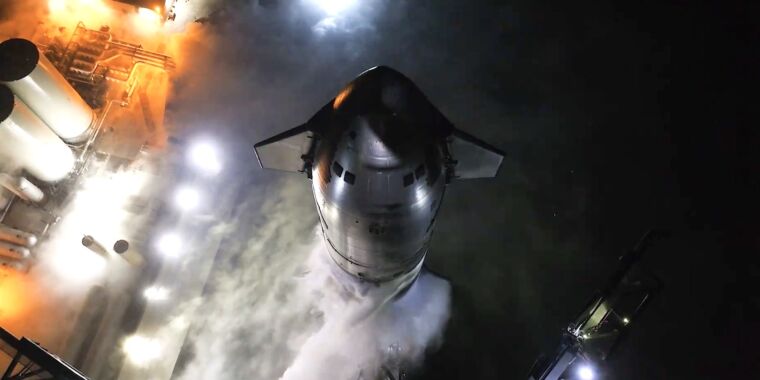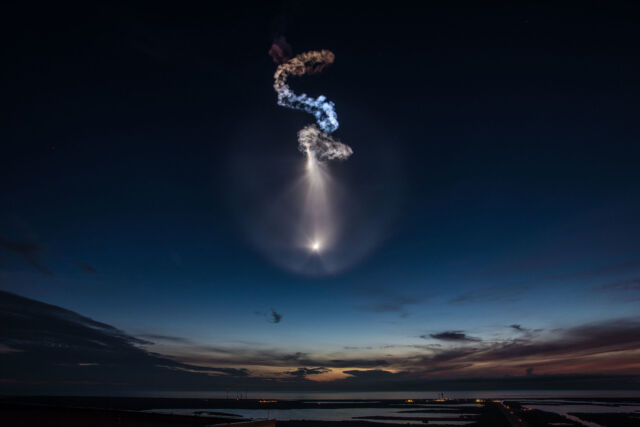SpaceX has a license to launch Starship—this time it might fly at dawn


The Federal Aviation Administration said Wednesday it has approved a commercial launch license for the third full-scale test flight of SpaceX’s giant Starship rocket.
This is the final regulatory hurdle before SpaceX can launch Starship from South Texas. The third flight of the world’s most powerful rocket, following a pair of test launches last year, is scheduled for Thursday morning.
SpaceX’s Starship rocket and Super Heavy booster will take off from the Starbase test site on the Texas Gulf Coast, a few miles north of the US-Mexico border. The launch window for the nearly 400-foot-tall (121-meter) rocket opens at 7 am CDT (12:00 UTC) Thursday and extends for 110 minutes.
“The FAA determined SpaceX met all safety, environmental, policy and financial responsibility requirements,” the regulatory agency said in a statement.
“The license applies to all phases of the proposed OFT-3 (Orbital Flight Test-3) operation,” the FAA said. “This includes preflight preparations and liftoff from Texas, the water landing of the Super Heavy booster in the Gulf of Mexico, and the water landing of the Starship vehicle in the Indian Ocean.“
This is the first time SpaceX will target the Indian Ocean for splashdown of Starship. The two test flights last year were supposed to culminate in a splashdown in the Pacific Ocean, but SpaceX has altered the trajectory for this launch in order to accomplish a few additional test objectives, including the restart of a Raptor engine in space for the first time.
The FAA performed a “tiered environmental assessment” to study the environmental effects of a Starship reentry and water landing in the Indian Ocean. Federal officials signed off on SpaceX’s proposal.
Green board
If Starship gets off the ground at the opening of Thursday’s launch window, it would lift off nearly 40 minutes before sunrise at Starbase. This would be the first night launch of Starship, but the timing of liftoff could be close enough to sunrise to allow sunlight to illuminate the rocket’s expanding engine plumes as it climbs into the upper atmosphere.
Twilight launches are spectacular and often produce a so-called “jellyfish” effect as sunlight reflects off ice crystals in a rocket’s exhaust trail. This colorful phenomenon is visually striking against a dark sky before sunrise or after sunset. Of course, the visibility of a rocket’s jellyfish exhaust trail depends on cloud cover, but assuming clear skies, a Starship launch at the opening of the launch window Thursday could be visible from as far away as Houston and other parts of the Gulf Coast.
The weather outlook for Thursday at Starbase looks generally favorable in terms of cloud cover, there are no thunderstorms in the official National Weather Service forecast. However, forecasters predict breezy conditions overnight Wednesday into Thursday, with gusty winds of 20 to 30 mph. SpaceX hasn’t said what the wind limit is for a Starship launch. There is also a chance of patchy fog overnight into Thursday morning, but this is not expected to be a factor in the launch other than for viewing conditions.

The results from the first Starship test flight last April were mixed. The blast from the rocket’s Raptor engines damaged the launch pad, and several of the booster’s engines failed before the vehicle tumbled out of control and self-destructed a few minutes after liftoff.
SpaceX upgraded the pad with a water deluge system to protect the ground infrastructure at Starbase from the blast and heat generated by the Super Heavy booster’s 33 Raptor engines. Engineers also made improvements in engine reliability, and changed the way Starship’s upper stage separates from its Super Heavy booster a few minutes into the flight. SpaceX also introduced a new “hot staging” technique, which involves igniting the upper stage’s six Raptor engines a fraction of a second before stage separation.
All these changes worked like a charm on the second Starship launch in November, and the Starship upper stage nearly reached its target velocity. During a planned vent of excess liquid oxygen, Starship developed a leak that resulted in a “combustion event,” ultimately causing the rocket’s computer to issue a self-destruct command.
The Super Heavy booster was supposed to attempt a controlled splashdown in the Gulf of Mexico in a test of SpaceX’s plans to recover and reuse the massive Starship first stage. The booster also self-destructed in the upper atmosphere after some of its engines, which were supposed to guide it back toward an offshore splashdown zone, lost pressure in their oxidizer turbopumps. SpaceX traced the cause of this problem to filter blockage in the liquid oxygen supply.
Source link




